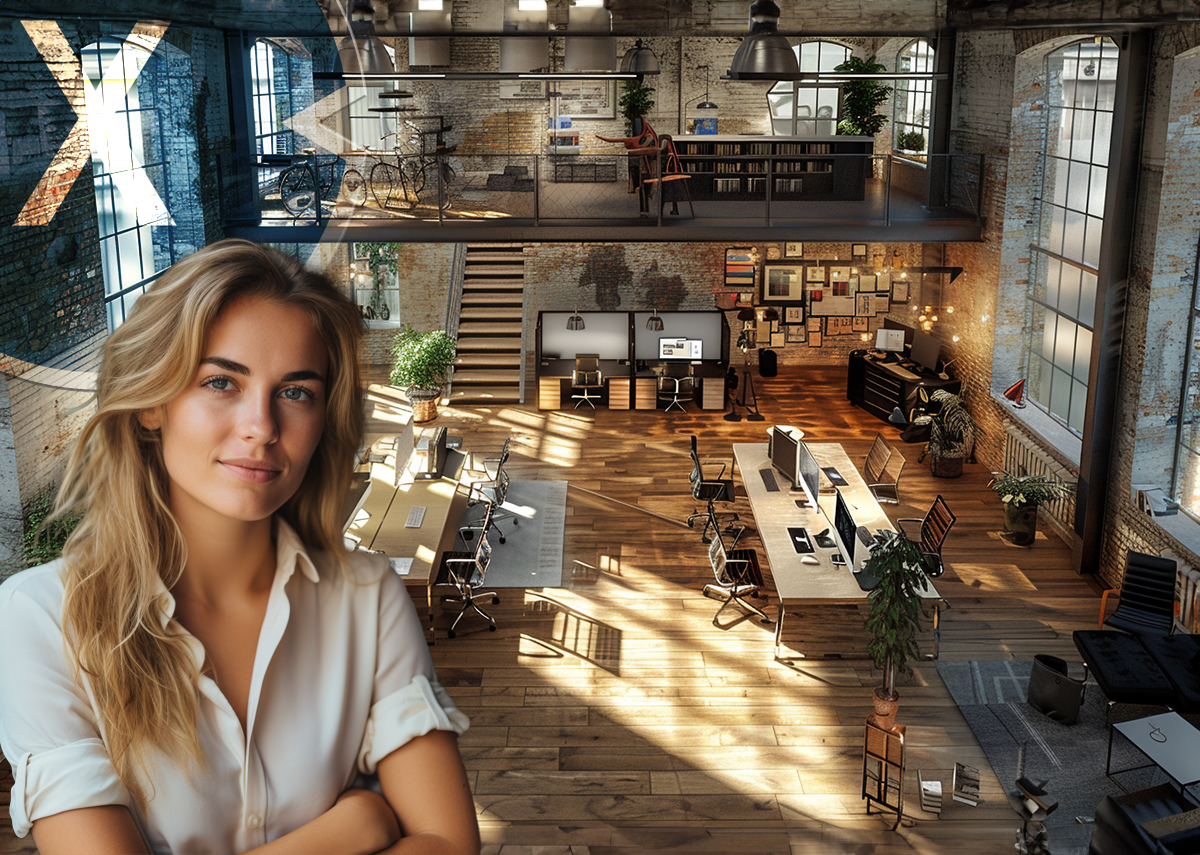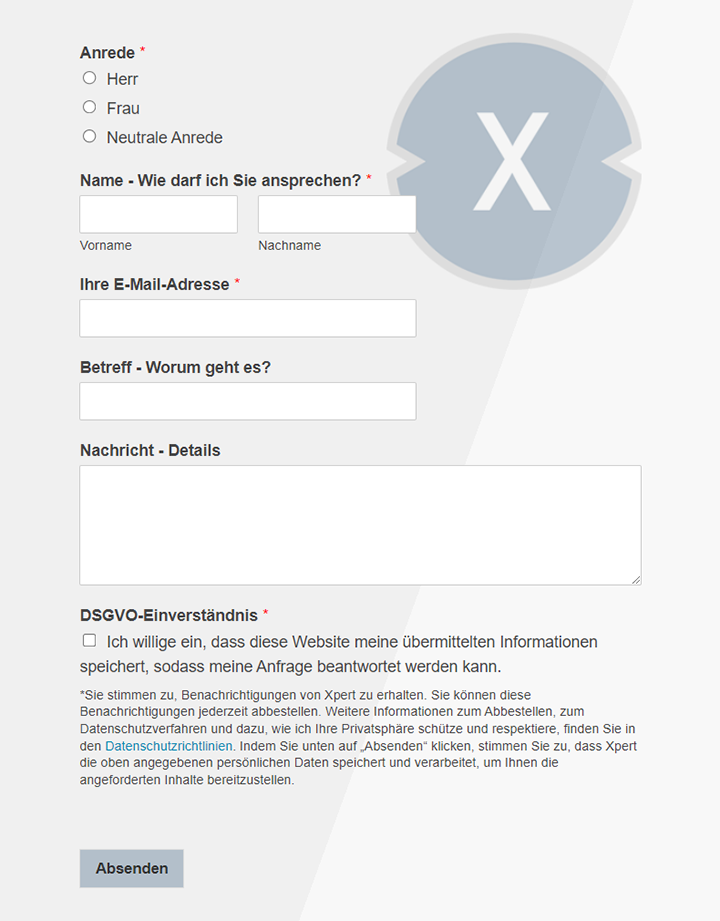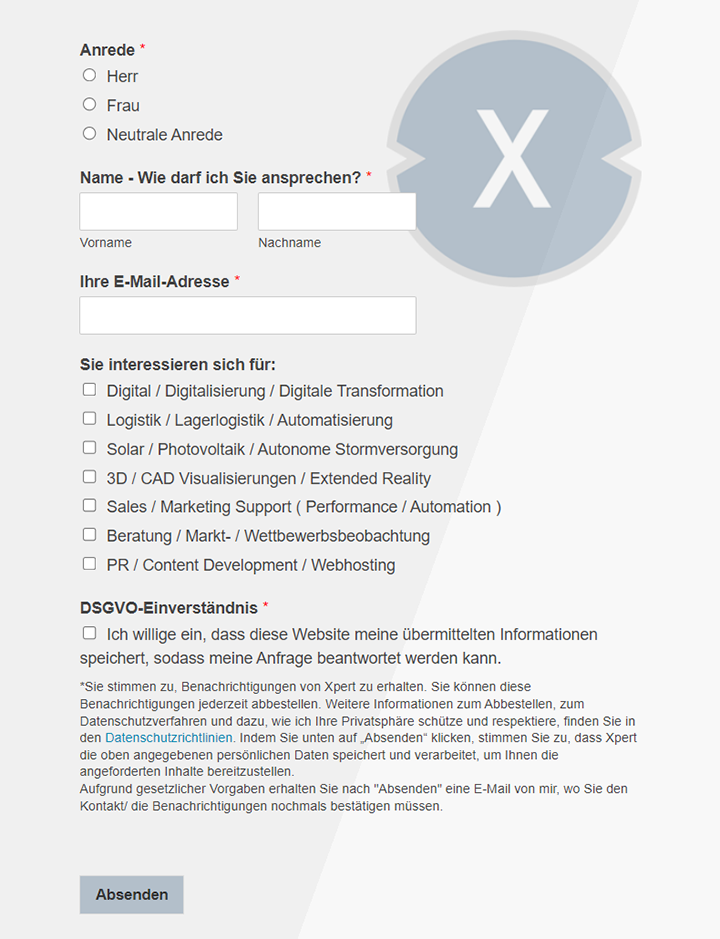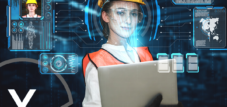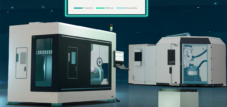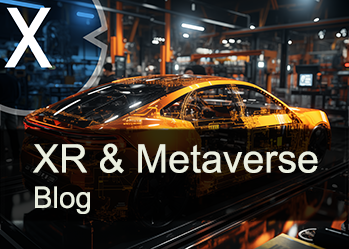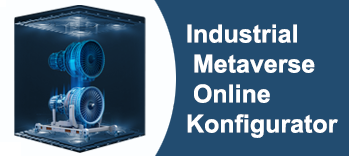Does 'Immersive Engineering' overtakes the meta -verses? Siemens and Sony do it
Xpert pre-release
Language selection 📢
Published on: February 9, 2025 / update from: February 9, 2025 - Author: Konrad Wolfenstein

Does the Immersive Engineering overtake the metaverse? Siemens and Sony demonstrate it - picture: xpert.digital
Forget the Meta-Verse hype! Immersive Engineering is now delivering - Siemens and Sony make it in industry
Is that the meta-verse breakthrough? Immersive Engineering with Siemens and Sony - the industry shows what really works
The development of the metaverse and immersive engineering shows an interesting dynamic, in which industrial meta -verse in particular is becoming increasingly important. While the general meta-verse concept is still looking for sustainable business models, industrial metavers are already experiencing strong integration into different industries. Here is a detailed analysis of the current trends and developments.
Immersive Engineering as pioneers of the industrial metaverse
Immersive engineering, i.e. the integration of advanced virtual reality (VR), augmented reality (AR) and mixed reality (MR) technologies in industrial processes, experiences a rapid upswing. This is particularly evident through strategic partnerships, technological advances and growing market forecasts.
Strategic partnerships and technological breakthroughs
Siemens and Sony Cooperation: A pioneering partnership between Siemens and Sony was presented at CES 2025. This combines Siemens' NX software for product development with Sony's state-of-the-art Head-Mounted Display (HMD) technology. The aim is to realize industrial meta -verses through immersive technologies and to raise digital product development to a new stage.
Applications in different industries
Immersive Engineering is already used in numerous industrial branches:
- Automobile construction: Virtual prototypes facilitate design processes and reduce physical test phases.
- Aerospace: complex construction processes can be simulated and optimized in digital twins.
- Energy supply: AR-based maintenance systems minimize downtimes of systems.
- Healthcare: VR-based training for surgeons enable realistic exercise scenarios.
Market growth and future prospects
The market forecasts for industrial metavers show enormous growth potential. Experts expect the market of $ 32.71 billion to increase to an impressive USD 395.15 billion by 2034 in 2025 with an annual growth rate of 32.05 %.
Suitable for:
- Metaverse / Multiverse: Siemens is expanding the Industrial Metaverse – From simulation to finished production site | Billion investment
- What is the Industrial Metaverse? What is the difference to the 3D platforms?
The general metaverse between hype and reality
While industrial metaverse is flourishing, the general meta verse faces major challenges. The question of whether it will take sustainable development or could end as a failed concept is the subject of numerous discussions.
2025 as a decisive year
Andrew Bosworth, CTO of Meta, described in 2025 as the “fate of fate” for the meta -verses. The pressure to deliver tangible results increases, especially since many investors are skeptical, whether the concept is long -term.
Financial challenges
Although META invests billions in the development of the meta -verse, the Reality Labs Division remains deficit. A loss of $ 4.97 billion was recorded in the last quarter. This leads to a strategic realignment.
Change of strategy: Focus on mixed reality
Meta plans the introduction of “half a dozen” new AI-based wearables and increasingly relies on mixed reality applications. This change of strategy is said to make metavers more attractive and more practical for companies and consumers.
Evolution instead of revolution: The role of immersive engineering
Immersive Engineering is not necessarily a departure from the meta verse, but rather an evolutionary development with concrete economic benefits.
Practical applications as a success factor
While the general meta verse is often perceived as a vague vision, immersive engineering already offers concrete added value:
- B2B orientation: Companies benefit directly from the technologies, be it in product development, maintenance or training.
- Technological convergence: Many of the technologies developed for metavers are used in a targeted and efficient manner in the industrial sector.
- Market maturity: While the general metaverse remains experimentally, the industrial metaverse has already proven to be sustainable.
Main features of Immersive Engineering
- Realistic visualization: Detailed 3D models and simulations enable an early analysis of products and processes.
- Interactive cooperation: Teams work regardless of the location in common virtual environments.
- Seamless integration: By connecting with existing CAD and PLM systems, immersive engineering can easily integrate into existing development processes.
AI as the driver of Immersive Engineering
Artificial intelligence plays a central role in the further development of immersive technologies. Here are some of the most important AI applications:
1. Optimization of design processes
- Generative AI enables the automatic creation and optimization of designs.
- Automated design suggestions accelerate the creative process.
2. Improved visualization
- AI-based rendering enable realistic representations in real time.
- Voice control and intuitive user interfaces improve interaction.
3. Data analysis and predictive maintenance
- Sensor-based AI systems recognize potential sources of error at an early stage and optimize maintenance processes.
4. Personalization and adaptive systems:
- AI can individualize immersive learning platforms and personalize user experiences.
The future of the metaverse lies in the immersive engineering
The current developments show that general metavers continue to fight with challenges, while industrial metavers and immersive engineering are established as viable solutions. This is mainly due to their clear applicability and direct economic benefits.
In the future, immersive engineering and AI-based technologies are expected to be integrated even more into industrial processes. Companies that rely on these technologies at an early stage could achieve significant competitive advantages and revolutionize the way in which products are developed, tested and serviced.
The development of the metaverse is therefore less than a radical revolution, but rather as a gradual adaptation to real needs and economic necessities.
Suitable for:
Our recommendation: 🌍 Limitless reach 🔗 Networked 🌐 Multilingual 💪 Strong sales: 💡 Authentic with strategy 🚀 Innovation meets 🧠 Intuition
At a time when a company's digital presence determines its success, the challenge is how to make this presence authentic, individual and far-reaching. Xpert.Digital offers an innovative solution that positions itself as an intersection between an industry hub, a blog and a brand ambassador. It combines the advantages of communication and sales channels in a single platform and enables publication in 18 different languages. The cooperation with partner portals and the possibility of publishing articles on Google News and a press distribution list with around 8,000 journalists and readers maximize the reach and visibility of the content. This represents an essential factor in external sales & marketing (SMarketing).
More about it here:
Metaverse outdated? The real metaverse? Forget the Meta-Verse hype! Immersive Engineering solves the hype - background analysis
Immersive Engineering: The development of meta -verse in industry
The landscape of digital technologies is experiencing a fascinating change, at the center of which the concepts of metavers and immersive engineering are. While the original Meta-Verse promise of a comprehensive, persistent virtual world for consumers is still waiting for its broad acceptance, a powerful and increasingly significant application in industry crystallizes: industrial meta-verse, driven by immersive engineering. This development does not indicate a replacement of the meta-verse concept, but rather to a pragmatic and promising development that focuses on specific, value-adding applications.
Suitable for:
- The Industrial Metaverse and digital transformation: The digital lighthouse project – Siemens Gerätewerk Erlangen (GWE)
- Metaverse: Differences between Industrial, Consumer, Customer and E-Commerce Metaverses | Wanted & Wanted Top Ten Tips Series
Immersive Engineering in detail: More than just a hype
In recent years, immersive engineering has developed from a promising idea to a real and transformative force in various branches of industry. It describes the use of advanced technologies such as virtual reality (VR), Augmented Reality (AR) and Mixed Reality (MR) in combination with high -performance computer technology and artificial intelligence (AI), a profound and interactive experience in product development, production and as a whole To create life cycle of products and systems.
Core principles and characteristics of immersive engineering
Realistic visualization and immersion
Immersive Engineering goes far beyond traditional 3D visualizations. It enables the representation of products, systems and processes in a hyper -realistic, three -dimensional environment, which allows the user to completely immerse yourself in the digital world. This is done by using head-mounted displays (HMDS), special projection systems and advanced rendering techniques that create a convincing depth perception, detailed textures and realistic lighting conditions. Engineers and designers can experience virtual prototypes in their actual size and the surrounding area, which enables an intuitive understanding and a more precise assessment.
Interactive and intuitive operation
Immersive environments are not only visually impressive, but also interactive. Users can interact with virtual objects and environments in a natural way, for example through gesture control, voice commands or haptic feedback systems. This intuitive interaction enables direct manipulation of 3D models, carrying out virtual assembly and disassembly processes or exploring complex system structures as if they were physically present. This not only becomes more efficient, but also more ergonomic and user -friendly.
Collaborative work environments
A decisive advantage of Immersive Engineering is the possibility of cooperation independent of the location. Teams from various disciplines and geographical locations can meet in common virtual rooms to work together on projects. You can examine virtual prototypes in real time, discuss design changes, simulate assembly processes or play through maintenance scenarios - and all of this as if they were in the same space. These collaborative possibilities accelerate decision -making processes, reduce communication barriers and promote interdisciplinary cooperation.
Integration into existing workflows
Immersive Engineering is not an isolated technology, but integrates seamlessly into existing engineering workflows and systems. It builds on established CAD, CAE and PLM systems and expands their functionality with immersive visualization and interaction. Data from these systems can be transferred directly to Immersive environments, and changes that are made in the virtual world can be reflected in the central data systems. This integration ensures a consistent data flow and avoids media breaks in the development process.
Data-driven knowledge and analyzes: Modern immersive engineering systems are closely linked to data analysis and AI technologies. You can record and analyze large amounts of data from simulations, sensors and production processes in order to gain valuable insights. For example, performance data of virtual prototypes can be analyzed to identify design optimization, or sensor data from real systems can be visualized in immersive environments to support maintenance teams in the error diagnosis and removal. This data-driven decision-making process increases the efficiency and quality of the engineering processes.
Technological foundations of immersive engineering
Head-mounted displays (HMDS) and Wearable Computing
HMDs are central hardware components for immersive experiences. Modern HMDs offer high -resolution displays, wide visual fields, precise motion tracking and comfortable ergonomics. They enable users to immerse themselves in virtual or augmented environments entirely and to interact with them. In addition to HMDs, other wearable technologies such as data gloves, full-body tracking systems and haptic vests also play a role to further improve immersion and interaction. The partnership between Siemens and Sony, which was presented at CES 2025, impressively demonstrates the potential of state-of-the-art HMD technology in connection with industrial software such as Siemens NX. Sony's XR HMD (SRH-S1) is an example of a device that was specially developed for demanding industrial applications and offers high image quality, robustness and ergonomics.
3D projection systems and caves
Large 3D projection systems or caves (Cave automatic virtual environments) are often used for group visualizations and collaborative applications. Caves are immersive rooms in which pictures are projected on several walls, the floor and the ceiling in order to create a comprehensive virtual environment. These systems enable several people to immerse themselves in the virtual world at the same time and to interact together, which is particularly advantageous for design reviews, virtual training or complex planning tasks.
High -performance computer infrastructure
Immersive Engineering applications require considerable computing power in order to render complex 3D models in real time, to carry out physical simulations and to make interaction in the virtual environment fluently. Powerful workstations, graphics processors (GPUS) and cloud computing infrastructures are therefore essential to ensure the necessary performance and scalability. The progress in chip technology and cloud computing has contributed significantly to making immersive engineering accessible for a broader application in recent years.
Specialized software platforms
A variety of software platforms and tools supports immersive engineering applications. This includes CAD software with VR/AR functionalities, simulation software, game engines (such as unity or unreal engine), as well as special immersive engineering platforms such as the NX Immersive Designer from Siemens. These software solutions offer functions for the creation and processing of 3D models, the development of interactive scenarios, the connection to data sources and collaboration in virtual environments. The continuous development of these software tools is crucial for the spread and success of immersive engineering.
Areas of application of immersive engineering: cross -sector transformation
Immersive Engineering is used in a growing number of industrial branches and revolutionizes traditional processes in areas such as:
Product development and design
Here is one of the greatest advantages of Immersive Engineering. Virtual prototypes enable engineers and designers to visualize, test and optimize products in an early stage of development - even before physical prototypes are built. This significantly reduces development times and costs because design errors can be recognized and remedied early. Immersive Design Reviews allow teams to examine products in original size and under realistic conditions, which leads to more well -founded design decisions and higher product quality. Generative design in combination with immersive visualization enables design rooms to explore and find innovative product solutions more efficiently.
Manufacturing planning and optimization
The planning and optimization of production lines and jobs is a complex process that benefits from Immersive Engineering. Fabrits and production environments can be reproduced and optimized virtually before they are physically built up. This makes it possible to test layouts, simulate material flows, to evaluate ergonomics and to identify potential bottlenecks. Virtual commissioning of production systems allows control systems and processes to test and validate before real commissioning, which saves time and costs and reduces the risk of errors.
Education and training
Complex assembly processes, maintenance procedures or the handling of dangerous systems can be trained in safe, virtual environments. Immersive training offers a realistic and interactive learning experience that is more effective than traditional training methods. Employees can make mistakes in virtual scenarios and learn from them without taking real risks. AI-based adaptive learning systems can adapt the level of difficulty of the training to individual learning progress and thus maximize the learning success.
Maintenance and repair
Immersive Engineering supports maintenance teams in the diagnosis of errors, repair and preventive maintenance of systems. By visualizing sensor data in immersive environments, anomalies and potential failures can be recognized at an early stage. Augmented reality applications lead to maintenance technicians step by step through complex repair processes and provide relevant information directly in the technology area. Digital twins of systems that are shown in immersive environments enable to simulate maintenance scenarios and develop optimal maintenance strategies.
sales and marketing
Immersive experiences can also be used in sales and marketing to present products and solutions in an innovative way. Potential customers can visit virtual showrooms, configure products in 3D and experience immersive product demonstrations. This creates a more emotional and more memorable brand experience and can positively influence the purchase decision. For complex products such as machines or systems, immersive presentations can convey the advantages and functions more vivid and convincing than traditional marketing materials.
Suitable for:
Advantages and potential of immersive engineering: a competitive advantage for companies
The introduction of immersive engineering in companies offers a variety of advantages and potentials that can lead to a significant competitive advantage:
Reduction of development time and costs
By using virtual prototypes and early error detection, companies can shorten development cycles and reduce costs for physical prototypes, material waste and rework. The increase in efficiency in design reviews and planning processes also contributes to cost savings.
Improvement of product quality and innovation
Comprehensive virtual tests and simulations make it possible to check and optimize products more thoroughly, which leads to higher product quality and reliability. The immersive visualization and interaction promote creativity and innovation, since engineers and designers can gain new perspectives and explore design rooms more effectively.
Promotion of interdisciplinary cooperation and communication
The collaborative possibilities of Immersive Engineering improve communication and cooperation between different departments, locations and external partners. Common virtual work environments reduce communication barriers and promote a common understanding of complex projects.
Optimization of manufacturing processes and increase in efficiency
Virtual factory planning and commissioning make it possible to optimize production processes, to eliminate bottlenecks and to increase the efficiency of production. Immersive training improves the qualifications of employees and reduce errors in production.
Improvement of security and sustainability
Virtual training and simulations make it possible to prepare employees in safe environments for dangerous situations and to avoid accidents. The reduction of physical prototypes and material waste contributes to more sustainable product development and production.
Market forecasts and growth trends: a billion dollar market in the creation
The market for Immersive Engineering and the industrial meta verse is in a phase of rapid growth. Market analysts forecast exponential growth in the coming years. Forecasts indicate that the global market for the industrial meta -verses of estimated $ 32.71 billion will grow to an impressive USD 395.15 billion in 2034 in 2025. This corresponds to an average annual growth rate (CAGR) of around 32.05%. This growth is driven by various factors, including:
Progress in VR/AR/MR technology
The continuous further development of HMDs, software platforms and computing power makes immersive engineering solutions more powerful, more affordable and more user-friendly.
Increasing acceptance in industry
More and more companies are recognizing the advantages and potential of immersive engineering and investing in corresponding technologies and applications. Early success stories and competitive pressure contribute to the distribution.
Digitization and Industry 4.0
Immersive Engineering is an integral part of digital transformation in industry and supports the implementation of Industry 4.0 concepts such as digital twins, networked production and data-driven decision-making.
Global challenges and increase in efficiency
In an increasingly complex and globalized world, companies are looking for ways to increase their efficiency, reduce costs and accelerate innovations. Immersive Engineering offers promising solutions for this.
The meta verse in context: from hype to industrial reality
While the general concept of the metaverse as a comprehensive, virtual social platform for consumers still has to deal with challenges and skepticism, industrial meta -verses - driven by immersive engineering - experiences a clear upswing. The focus is on the difference and in the specific applications. While consumer meta verses are often perceived as a still diffuse and difficult to tangible concept, the industrial meta verse measurable advantages and a clear return on investment for companies.
Challenges and realities of the consumer meta verse
The initial euphoria about the meta verse for end consumers has subsided somewhat in recent years. Despite great investments and ambitious visions, companies such as Meta that invest strongly in this field faces considerable challenges. Meta's Reality Labs Division continues to record high losses, even though the company achieves record sales. Industry insiders such as Andrew Bosworth, CTO of Meta, see the year 2025 as crucial to assess whether the Metaverse concept for consumers actually creates or fails. Some of the main reasons for skepticism and the challenges in consumer meta verses are:
Lack of killer applications
There is still a lack of convincing applications and content that inspire the general public and make regular meta-verse users. Many existing applications are more niche products or demonstrations of technological potential as essential components of everyday life.
Technical hurdles and user -friendliness
The technology has not yet been fully mature to ensure a seamless and comfortable meta-verse experience for all users. HMDs are often still chunky, expensive and not optimized for long -term use. Operation and navigation in virtual worlds can still be cumbersome and unintended for many users.
Questions of identity, privacy and security
Metaverse raises complex questions regarding digital identity, data protection, data security and virtual social interaction. Clear ethical guidelines and technical solutions are required to prevent abuse, harassment and other negative aspects.
High investment costs and long amortization times
The establishment of a comprehensive meta-verse infrastructure requires enormous investments in hardware, software, content and infrastructure. The amortization of these investments is uncertain and depends on the success of the meta-verse applications and the acceptance by the users.
The rise of industrial meta verse: pragmatism and added value in the focus
In contrast to the consumer meta verse, industrial metaverse focuses on concrete, business-critical applications in industry. It uses the same basic technologies as VR, AR and MR, but specifically focuses on the needs and requirements of companies. Industrial metavers are not geared towards entertainment or social interaction, but is based on increasing efficiency, reducing costs, improvement in quality and promoting innovation in industrial processes. This pragmatic approach and clear added value make industrial meta-verses a more promising and faster growing area than the general meta-verse concept.
Evolution instead of revolution: immersive engineering as pragmatic implementation
Immersive Engineering thus represents an evolution of the meta-verse concept, which focuses on practical applications and measurable results. It is not a revolution that overtakes the meta-verse, but rather an intelligent and targeted further development that uses the strengths of meta-verse technologies and translates it into concrete industrial solutions. The focus is on clearly:
Practical applications and added value
Immersive Engineering focuses on applications that create direct and measurable added value for companies, such as cost reduction, increase in efficiency, quality improvement and promotion of innovation. The benefit is clearly recognizable and justifies the investments in technology.
B2B orientation and industrial needs
The focus is on business-to-business solutions that are specially tailored to the needs and requirements of industrial companies. The applications are optimized for industrial processes and workflows and integrate seamlessly into existing IT infrastructures.
Technological convergence and synergy effects
Immersive Engineering uses many of the technologies that have also been developed for general metavers, such as VR/AR/MR, 3D modeling, real-time rendering and collaboration tools. However, it intelligently combines these technologies with other industrial technologies such as AI, data analysis, simulation and IoT to achieve synergistic effects and create comprehensive solutions.
Market maturity and establishment by industrial partners
While the broad meta-verse concept is still looking for its identity and acceptance, the industrial metaverse is already ready for market and is actively promoted by established industrial companies like Siemens. The partnership between Siemens and Sony is a clear sign of ripening and the potential of this technology.
Artificial intelligence (AI) as a catalyst for Immersive Engineering
The integration of artificial intelligence (AI) plays a crucial role in the further development and success of immersive engineering. AI technologies not only improve the functionality and user-friendliness of immersive systems, but also open up new areas of application and potential.
AI-based optimization of design processes:
Generative design and design optimization
AI algorithms, especially generative AI, can support and optimize complex design tasks. You can automatically generate design suggestions, optimize design parameters and find the best balance between different requirements such as performance, costs and manufacturing. Immersive environments enable designers to visualize the generated design suggestions in 3D and to evaluate them interactively, which accelerates the design process and leads to more innovative solutions.
Automated design suggestions and assistance systems
AI-based assistance systems can relieve engineers and designers for routine tasks and provide them with valuable design suggestions. You analyze existing design data, specifications and best practices to automatically generate design elements, check design rules or identify errors. Immersive user interfaces enable intuitive interaction with these assistance systems and facilitate the integration of AI functions into the design process.
Improved visualization and interaction by AI:
Photo-realistic renderings and real-time visualization
Generative AI accelerates the creation of detailed, photo -realistic renderings. Tasks that lasted for days or weeks can now be done in hours or even minutes. AI-supported rendering algorithms optimize the rendering process, improve the image quality and enable real-time visualization even complex 3D models in immersive environments.
Intuitive user interfaces and natural interaction
AI-supported systems such as voice assistants (e.g. the NX Voice Command Assistant from Siemens) enable a more natural and intuitive interaction in immersive environments. Users can use voice commands to interact with virtual objects, operate menus or carry out complex tasks. AI algorithms for gesture recognition and viewing recognition further improve the interaction and make immersive systems more user-friendly and more efficient.
Data analysis and decision support with AI:
Predictive maintenance and error diagnosis
AI algorithms can analyze large amounts of sensor data from systems and production processes in order to identify potential failures at an early stage and optimize maintenance measures. Immersive environments enable maintenance teams to visualize the analyzed data in 3D, identify errors and to plan and carry out repair processes more efficiently. Augmented reality applications can support maintenance technicians on site with AI-based instructions and information.
Optimization of operating processes and process control
AI systems can analyze complex operations and identify optimization potential. For example, airlines use AI to optimize flight routes, taking weather conditions, air traffic and fuel consumption into account. Immersive environments can be used to visualize complex production processes, carry out simulations and support AI-supported decision-making. Real-time data analyzes in immersive dashboards enable managers to keep an overview of complex processes and react quickly to changes.
Personalization and adaptation of immersive experiences by AI:
Adaptive learning environments and personalized training
In the area of immersive learning, AI systems can analyze individual learning preferences and optimize learning concepts. Adaptive learning environments adapt the level of difficulty, the content and pace of the training to the individual learning progress of each user. AI-supported tutors can give personalized feedback and recommend individual learning paths.
Context -sensitive information and assistance systems
AI can provide relevant information based on the user behavior, the context and the current tasks in real time. Immersive assistance systems can lead users through complex processes, display relevant documentation, provide warnings or provide decision -making recommendations - and all context -sensitive and in an intuitive immersive environment.
Integration of AI in development tools for Immersive Engineering:
AI-based software platforms and development environments
Software platforms for Immersive Engineering are increasingly integrating AI technologies to simplify and accelerate the development processes. Examples are the NX Immersive Designer from Siemens, which uses AI functions for intuitive interaction, design optimization and data analysis. AI -supported development environments automate repetitive tasks, support error detection and correction and enable more efficient development of high -quality immersive applications.
Immersive engineering and industrial metavers - the future of industry
Immersive Engineering and industrial meta-verse are currently representing the more tangible and more promising aspects of the meta-verse concept. They do not overtake the meta-verses, but rather represent its practical and economically viable implementation in the current technological landscape. By combining VR/AR/MR technologies, high-performance computer technology and artificial intelligence, they open up new opportunities for increasing efficiency, cost reduction , Quality improvement and innovation promotion in almost all areas of industry. While the general meta-verse promise for consumers is still waiting for its broad acceptance, industrial metavers are already reality and will probably play a transformative role in industry in the coming years. The partnership between Siemens and Sony and the impressive market forecasts underline the immense potential of these technologies and indicate a future in which immersive experiences and virtual worlds will be an integral part of industrial processes and working methods.
We are there for you - advice - planning - implementation - project management
Xpert.Digital - Pioneer Business Development
Smart Glasses & KI - XR/AR/VR/MR industry expert
Consumer metaverse or meta -verse in general
If you have any questions, further information and advice, please feel free to contact me at any time.
I would be happy to serve as your personal advisor.
You can contact me by filling out the contact form below or simply call me on +49 89 89 674 804 (Munich) .
I'm looking forward to our joint project.
Xpert.Digital - Konrad Wolfenstein
Xpert.Digital is a hub for industry with a focus on digitalization, mechanical engineering, logistics/intralogistics and photovoltaics.
With our 360° business development solution, we support well-known companies from new business to after sales.
Market intelligence, smarketing, marketing automation, content development, PR, mail campaigns, personalized social media and lead nurturing are part of our digital tools.
You can find out more at: www.xpert.digital - www.xpert.solar - www.xpert.plus



